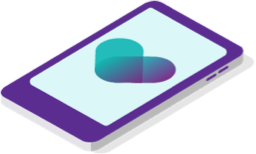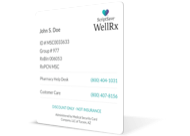Copyright 2024
Medical Security Card Company, LLC
All Rights Reserved
WellRx will never sell your personal information. Period. By signing up I agree to WellRx's terms of use and privacy policy.
By Teresa Otto, MD
October 25, 2022
It’s hard to imagine Simone Biles and Michael Phelps having difficulty with concentration, given their Olympic successes. In addition to their athletic abilities, didn’t they need an unwavering focus, persistence, and attention to detail to succeed?
They did. And both have managed to do so with attention deficit hyperactivity disorder (ADHD).
ADHD is the most commonly diagnosed neurodevelopmental disorder in children. It usually continues into adulthood.
Let’s look at ADHD, who it affects, the symptoms, the diagnosis, including a link to a screening self-test you can take, treatment options, and how to find the lowest prescription prices for ADHD medications.
Even though ADHD is common, it may be underdiagnosed and is often misunderstood. During October, ADHD organizations seek to educate the public about this disorder. Here are a few facts about ADHD:
ADHD is a neurodevelopmental disorder meaning that it affects the way the brain grows and develops. While every young child cannot concentrate or focus on things for any length of time, children with ADHD don’t grow out of this stage.
Surveys show that 5% of all children and 2.5% of all adults worldwide have ADHD, but experts believe only about half of the children with ADHD are diagnosed. In the United States, the number of children who have been diagnosed at some point in their lives is closer to 10%. More than 6 million American children from 3 to 17 years of age have ADHD.
Boys are diagnosed twice as often as girls, maybe because boys more often have associated hyperactivity.
Genetics plays a significant role in ADHD. Children of parents who have ADHD are more likely to have the disorder. The same goes for identical twins. If one identical twin has ADHD, the other will have it, too.
With that being said, the environment may play a role, too, beginning with the prenatal environment. Both the structural and functional development of a baby’s brain occurs throughout the entire pregnancy. A healthy prenatal environment includes:
After birth and throughout childhood, environmental factors leading to ADHD or worsening ADHD aren’t as clear. A brain injury or childhood stroke may lead to ADHD. Fetal or early childhood exposure to lead may lead to ADHD, too.
Three types of ADHD exist. They’re grouped together because each one is a form of neuro-divergence. People without ADHD think in a neuro-typical fashion. People with neuro-divergence process information differently, behave differently, and/or learn differently from the ways others typically do.
This is not a right vs. wrong differentiation. It is a matter of whether your brain operates like the majority or a minority of people. ADHD, as such, is not a disease; it’s a disorder.
The three types of ADHD are:
The combined inattention and hyperactive/impulsive type of ADHD is the most common, while the hyperactivity/impulsivity type is the least common.
Children are more likely to have hyperactivity associated with ADHD. A child’s ADHD may be first recognized as the child starts school and the child’s behavior isn’t appropriate for his age. The child’s hyperactivity and impulsive behavior disrupt the classroom. The child’s inability to sit still and frequent interruptions are hallmarks of ADHD. More symptoms include:
A child with inattentive ADHD may not disrupt classmates as often but may struggle academically to keep up with the rest of the class. Typical symptoms of inattentive ADHD include:
With combined ADHD, neither hyperactivity/impulsiveness nor inattention symptoms are predominant.
ADHD continues into adulthood for most people, although symptoms may change.
In adults with ADHD, hyperactivity won’t manifest as it does in a child with ADHD at recess but instead may manifest as workaholic tendencies, talking a lot, interrupting others, or restlessness. Hyperactivity in adults may also wane while other symptoms get worse, such as:
In adults, symptoms of inattentive ADHD, particularly disorganization, an inability to stay focused, and procrastination, may show up as:
Adults with undiagnosed or untreated ADHD may find symptoms worsen over time. They are more likely to experience:
There is no single test for ADHD. Your healthcare provider will gather information about your child’s symptoms and level of impairment, review the timeline of symptoms, and look for behavior that’s inappropriate for your child’s developmental stage.
In addition to symptoms, a few criteria need to be met for your child to receive a diagnosis of ADHD:
When discussing your child’s symptoms with a healthcare professional, it’s important to include feedback from teachers at school.
If you weren’t diagnosed with ADHD as a child but notice symptoms or patterns in your life consistent with ADHD, have your physician or a licensed mental health profession evaluate you.
The evaluation includes looking at the number and severity of symptoms, how long you’ve had symptoms, and how much the symptoms impair your daily life.
Self-assessment tests can help you determine if what you feel and experience are consistent with ADHD. These tests don’t replace an evaluation by a healthcare professional.
Treatment for ADHD is multi-faceted. The American Academy of Pediatrics approaches treatment based on your child’s age.
For children four to six years old, treatment includes:
For children over six years old, treatment includes a combination of behavioral management and medications. The Food and Drug Administration (FDA) has approved several medications for ADHD:
Adults can focus their treatment on areas of their lives most impacted by ADHD. Treatment may involve help with time management, organizational skills, or relationships. Treatment approaches include:
ADHD requires ongoing treatment with medication, so costs can add up quickly. At ScriptSave® WellRx, you can compare prescription prices at a pharmacy near you. The comparison pricing tool works for both prescription and over-the-counter medications. A quick check on Ritalin LA saved more than 75% and even more on Strattera.
In addition, to easily finding the lowest prescription price, you can instantly receive coupons for medications (via text, email, or computer download) or enroll for a free Rx savings card.
To learn more about how prescription discount cards work and the free services WellRx offers, watch this 30-second video.
Adjunctive therapies are not meant to replace proven ADHD treatments but to enhance them. Please discuss the risks and benefits with your healthcare provider before adding them to your treatment plan.
Omega 3 fatty acids, found naturally in fish, can have positive effects on ADHD. You can eat fish such as salmon, sardines, cod, or trout once or twice a week. Alternatively, you can take daily fish oil capsules containing at least 500 milligrams of EPA (Eicosapentaenoic acid).
Combinations of other vitamins and minerals (micronutrients) that promote a healthy brain seem to be beneficial as well. It’s best to get these micronutrients from the vegetables, fruits, proteins, and fats you eat. But if you eat a lot of processed foods, you may not be getting the nutrients you need.
Some research suggests improved attention and better emotional control after taking micronutrient-containing supplements for several weeks.
Exercise hasn’t been proven to specifically reduce ADHD symptoms, but regular exercise has been shown to improve cardiovascular health, your sense of well-being, and your cognitive abilities. Martial arts, ballet, ice skating, and gymnastics appear beneficial for those with ADHD.
The FDA approved EndeavorRx, a game-based therapeutic device, for ADHD treatment. Eight- to 12-year-olds with ADHD showed improvement in their inattentive or combined ADHD after using the device.
Ancient practices of meditation and yoga help children and teens with ADHD and stress management. Newer brain training includes Cogmed — a computer program that helps build working memory. Another newer brain training technique involves neurofeedback, in which people with ADHD learned to increase beta brain waves and thereby reduce ADHD symptoms.
Federal laws ensure children with ADHD have the right to free public education and the help they need if they are “substantially” limited by the disorder.
For adults, employers who employ more than 15 people are required to accommodate people with disabilities under the Americans with Disabilities Act (ADA). Some exceptions apply to military members and government employees.
If you are not covered by the ADA, you may still be covered under local or state laws.
Teresa Otto, MD, is a freelance medical writer on a mission to inform readers about the positive impact of good nutrition and a healthy lifestyle. She is a retired anesthesiologist who practiced in Billings, Montana, for most of her career. She graduated from the University of Washington School of Medicine in Seattle and did her anesthesia residency and fellowship at New York University and Columbia-Presbyterian in New York.
Resources:

For your convenience, use the ScriptSave® WellRx mobile app. Now savings are well in hand, right at the pharmacy counter. Save on your family's prescription medicines.
Learn More
Your choice. Get a ScriptSave WellRx Savings Card. Or Download the free mobile app from the App Store or Google Play Store
Get A Card
ScriptSave WellRx Grocery Guidance leverages leading-edge nutritional data science to help you know which food products on your grocery store shelf are truly good for YOU.
Healthy Foods For YouTags:

November 07, 2024

October 23, 2024

May 07, 2024
You need to log into the site to use this feature
This feature requires registration. Sign up or log in to your free WellRx account to gain access to this and other tools to help make managing your medications and wellness easier.
Benefits Include:
 Store & manage your medication list
Store & manage your medication list
 Medication pricing updates
Medication pricing updates
 Medication information
Medication information
 Pill & refill reminders
Pill & refill reminders
 Medication journal & mood log
Medication journal & mood log
This feature requires registration. Sign up or log in to your free WellRx account to gain access to this and other tools to help make managing your medications and wellness easier.
Benefits Include:
 Store & manage your medication list
Store & manage your medication list
 Medication pricing updates
Medication pricing updates
 Medication information
Medication information
 Pill & refill reminders
Pill & refill reminders
 Medication journal & mood log
Medication journal & mood log
You will be redirected to your program in 5 seconds.
Our Terms and Conditions and Privacy Policy have recently been updated.
By declining you will be logged out of your account